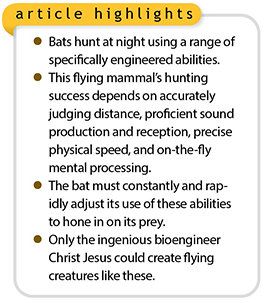
Bats are mysterious, marvelous mammals of prey, even in a fallen world where omnivorous predation is common.1 Because bats are mostly nocturnal, only beginning their aerial hunting at sunset, their nighttime foraging habits often go unseen by human observers.1,2
Scientists can discern certain aspects of bats’ gustatory preferences by their digestive byproducts.2 But even apart from reviewing the menus of bat diets, consider how prey-chasing bats hunt for “fast food” using echolocation, a perfect illustration of continuous environmental tracking.3 Let’s look at seven critical factors and real-time challenges of a bat employing sound to locate and capture its food.
First, the bat must factor distance.
A bat’s call must be strong enough to make the outward journey to a target and the return journey back to its ears. But sounds quickly lose energy as they travel through air, especially when they’re high in frequency, so echolocation only works over short ranges.4
Second, ultrasound volume counts, too. Big brown bats emit sonar calls at 138 decibels, like ambulance sirens. Other bats shriek at 110 decibels, like chainsaws. Thankfully, these anatomy-enabled noises are pitched beyond human hearing.4,5
Third, speed matters. Each sonar call/echo pair is the sound equivalent of a snapshot. These serial snapshots must be updated (and interpreted) quickly enough to resemble watching a movie. Otherwise, evasive prey—like flies, mosquitoes, wasps, caddisflies, moths, crickets, frogs, small birds, or near-surface fish—can flee and escape.4,6
Fourth, emitted calls cover a band of sound-wave frequencies at one or two octaves, bouncing sound waves off specific body parts of targeted prey. The bat’s sonar data-analysis software/hardware systems interpret this real-time data to produce detailed images of the target’s physical shape and changing locations.4,5
Fifth, as the bat flies—one active example of complicated motion—the repeated sonar emissions must unerringly track the targeted-yet-dodging prey, which is another active example of complicated motion.6 As the capture distance shortens, the prey’s ever-changing location must be precisely adjusted for, with brief-yet-close-together pulses of sound that are separated enough to avoid garbled “blurring” of overlapping calls and echoes.
The bat must compute space from the timing of its echoes, and since echoes returning from the two equidistant [objects] would arrive after the same delay, they might sound like the same object.4
Sixth, there’s a sonar version of camouflage. Tiny prey, like mosquitoes or flies, can get “lost” against a larger background (like radar chaff) such as leaves or tree bark.4 Seventh, bats live in colonies; they often hunt in packs. Thus, bats must informationally distinguish their own call-echo sound data from that of other bats in order to focus on their own prey pursuits. Yet, sonar data from other bats can’t be ignored. Otherwise, bats would collide into each other as they hunt.1,4
There’s more, of course, but this sufficiently shows how the supposedly “simple” habit of bats going out to eat—while actively acquiring external information (continuous environmental tracking)—demands that bats be bioengineered by someone who is a whole lot smarter than the smartest of humans.
That super-ingenious someone is the Lord Jesus Christ (John 1:1-3).
References
- The author visited the “bat bridge” (Congress Avenue Bridge) in Austin, Texas, where up to 1.5 million Mexican free-tailed bats literally hang out thereunder in North America’s largest urban bat colony. These summer migrants energetically emerge at dusk to hunt mosquitoes and other insects along the Colorado River.
- Like moles, the habits of bats are difficult to observe (Isaiah 2:20). Bat diets are better known now by scrutinizing their feces (guano) at surprising levels of detail, including recognizing DNA of digested prey. See Jones, P. L. et al. 2020. Sensory ecology of the frog-eating bat, Trachops cirrhosus, from DNA metabarcoding and behavior. Behavioral Ecology. 31 (6): 1420-1428.
- Visit ICR.org/cet for more information on this engineering-based biological model.
- Yong, E. 2022. An Immense World: How Animal Senses Reveal the Hidden Realms Around Us. New York: Random House, 249-254, quotes from 248-249, 252.
- Sherwin, F. Bat Echolocation Defies Evolutionary Explanations. Creation Science Update. Posted on ICR.org January 31, 2022; Sherwin, F. 2003. Bat-tastic Bats. Acts & Facts. 32 (10).
- Übernickel, K. et al. 2016. Sensory challenges for trawling bats: Finding transient prey on water surfaces. The Journal of the Acoustical Society of America. 139 (4): 1914-1922.
* Dr. Johnson is Associate Professor of Apologetics and Chief Academic Officer at the Institute for Creation Research.













